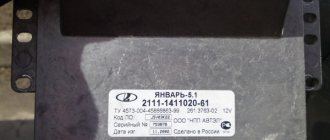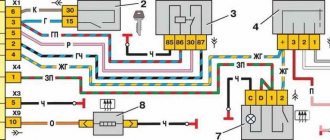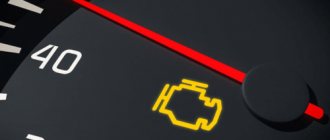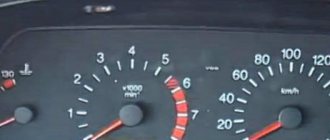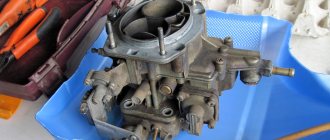1—for a week now, some crap has been going on in the mornings. It won’t start the first time, but the fuel pump pumped up the gasoline, everything is fine, I start it and it still has holes in it two or three times and stalls. I repeat the procedure ——- holes in it and stalls. The computer is silent, not at all. errors. I checked the fuel pump purely like in the operating room. The third time with half a turn. —— But then comes the second crap. I plugged in the first one, left the yard, switched to netralka and the revs didn’t drop. I had to turn it off and start it again. (I’ve already changed 3 idle speed sensors) Either it’s the sensors or it’s a mystery of nature. Tomorrow I think I’ll deal with these problems. I'll let you know the results.
Well, I fixed it; the problem was in the spark plugs. Before this I changed the spark plugs and installed NGK ones. and got hemorrhoids. I returned the BOSH SUPER PLUS back. and how the grandmother whispered. I don’t want to say anything bad about NGK, it’s just random. In general, I’m once again convinced that if it works, there’s no point in messing with it.
What is the reason why the injector takes a long time to start? The problem can be caused by various reasons, because the engine takes a long time to start not only when cold, but also when hot. Could this mean that the starter rotation time has nothing to do with temperature or not?
The most common reasons: what is the problem?
It is worth noting that a malfunction can be determined by indirect signs without even opening the hood of the car.
For example, if the starter turns, but the engine does not catch on or immediately stalls, the problem lies in the fuel system. Without exception, all the reasons for the impossibility of starting the engine can be divided conditionally into two main groups: It is also necessary to include the following in a separate category of faults: the engine “knocked”, the timing belt broke. In this case, expensive repairs will be required. In other cases, you can get by with a little bloodshed.
Attention - air
Finally, another possible reason for sudden movements of the needle is the presence of air bubbles in the antifreeze (“airing” of the system). Since the air and antifreeze have different temperatures, the needle jerks. An indirect sign of this malfunction is the splashing of coolant from the radiator cap or expansion tank, as well as a decrease in the filling volume.
PS In order not to upset Logan drivers, on the Duster and the second generation Logan-Sandero the temperature indicator on the dashboard was completely removed. As they say: no pointer, no problem.
The main problems associated with the operation of the fuel system
Engine starting is primarily affected by the following main components of the fuel system:
- gasoline level in the tank;
- the condition of the fuel line under the bottom of the car;
- cleanliness of filters.
It should be noted: even if there is gasoline in the tank, the car may not start. And the reason for this is the low fuel level. The pump may simply not be drawing in enough gasoline. Therefore, before starting to diagnose and inspect all the main components, it is advisable to fill the tank to at least a third. If problems with the electrical part are excluded, you need to pay attention to the fuel line. You need to check:
- no breakdowns or leaks in the fuel supply pipe under the bottom;
- the condition of the fine filter - often it simply becomes clogged, which leads to a decrease in the pressure level in the fuel system.
It is not possible to check the operation of the fuel pump manually on this car. This can only be done by ear. If, when you turn the key and turn on the ignition, the pump makes noise, then it is “alive”. Otherwise, you need to check whether power is supplied to it. If this is all right, you need to replace the pump. Its cost ranges from 1.5 to 3 thousand rubles, depending on the manufacturer.
You can check the pressure level yourself - just connect a special pressure gauge to the fuel system in accordance with the manual. This will allow you to diagnose the problem. According to the standard, the pressure should be at least 2-2.5 atm. If the indicator is less, then the engine will not start.
Clogged filters
This problem can occur in both summer and winter. And this applies not only to the fuel filter, but also to the air filter. The latter is in a special plastic case. On VAZ 15th model cars it looks like this.
After moving the latches, lift the air filter housing cover and remove the cleaning element itself. If it is dirty, the part needs to be replaced. Filters are consumables and cannot be restored at home. Moreover, they cost pennies. As for the fuel filter, it is located under the bottom of the car. The element looks like in the photo below.
If the car has driven more than 30 thousand kilometers, the filter should be replaced. You will not be able to visually determine the degree of contamination as you can in the air. The part is located in a closed, non-separable case. It has porous paper inside. It is capable of passing particles smaller than 10 microns. Over time, the pores of the paper become clogged, and the filter is not able to pass the required amount of fuel through itself. So that the problem does not take you by surprise, change this part in advance.
A characteristic sign of failure is jerking when moving (as if the fuel supply to the cylinders had stopped for some time). This means that the submersible pump is not able to supply the required amount of fuel through the paper pores. As for the air filter, it is changed every 6 months or every 10 thousand kilometers. By following the regulations, you will protect yourself from such problems.
The starter works, the engine turns, but the car does not start
So, the starter, like the engine, the pistons move, but the engine still won’t start. There is already a problem here, most likely in the fuel-air mixture, perhaps the marks have come off, etc.
Before you sin on this, the first thing you need to pay attention to is the crankshaft sensors:
DPKV - if it malfunctions, it is very difficult to start the engine, and once it is running, it runs unevenly, intermittently, and the power drops noticeably.
Next you should pay attention to the labels:
- Mark on the timing camshaft gear (photo).
- Markings on the flywheel under the thermostat (photo).
If the marks do not match, most likely the belt has simply slipped by one tooth. The camshaft gear itself may be worn. It needs to be adjusted and installed correctly!
Next we will talk about the air-fuel mixture.
I warn you in advance that the easiest way is to do computer diagnostics of the engine or look at the errors on the on-board computer.
The air-fuel mixture is the combination of air, gasoline, and the spark needed to ignite it.
Air supply
As a rule, a malfunction in the air supply should not affect the engine starting problem. At the very least, the engine should still run. Nevertheless, let's not bypass the air system.
The following sensors are responsible for air metering and supply:
- Mass air flow sensor is the most expensive sensor. If it fails, then the car simply begins to consume liters of gasoline, then this sensor can simply die “to zero”, but it indirectly affects the starting of the car. This means, no matter how it fails, the car should start.
- The IAC should not affect the engine starting problem. If it malfunctions, problems arise from idle.
Spark
Here may be the real reasons for our problem:
- First of all, we look at the candles. We turn them inside out (How to remove candles?) and look at their condition. Normal ones should have a slightly brick color, if they are wet, the candles will flood accordingly. It is necessary to clean and bleed the cylinders by idling the engine with the starter with the spark plugs turned out. If one cylinder is flooded, the problem is local (high-voltage wires, faulty spark plug, injector), all cylinders are flooded - a general problem (ignition coil, brains, oxygen sensor, fuel pressure in the rail).
- Next, check for the presence of a spark. To check it, check out the following article: How to check the spark?
- If there is no spark on one cylinder, there is a faulty spark plug or high-voltage wire.
- If it is missing on two adjacent cylinders (1-4 or 2-3), then the problem is in the ignition coil or in the ECU.
- If there is no spark anywhere, the problem may lie in the ignition coil or ECU, in mismatched timing marks, or inoperative DPKV.
- If there are no problems with the presence of a spark, then the cause of the malfunction lies in the fuel supply.
About spark plug gap
Over time, the gap between the electrodes increases. The normal parameter is from 0.7 mm to one millimeter. You can check this gap using a special feeler gauge.
The same is used for setting valve clearances on carburetor engines. So, if a parameter does not meet the norm, it should be adjusted. To do this, you should use a negative screwdriver. To reduce the gap, press the end of the plug onto the top electrode of the spark plug. With your other hand, hold the part itself. If you “overdid it”, it doesn’t matter – everything can be returned back. To do this, bend the electrode with the edge of a screwdriver (it bends quite easily) and check the distance again. It is worth noting that with a correctly set gap, you can not only ensure trouble-free engine starting, but also reduce fuel consumption by 5 percent. Also the car will run smoothly. After all, the mixture is ignited exactly at the moment when it is necessary. And the last thing is the resource of the candles themselves. If the gap is higher or lower than normal, the risk of breaking through the insulator increases significantly. As for the replacement schedule, it is about 40 thousand kilometers. It is recommended to replace the high-voltage wires along with the spark plugs.
Problems associated with the electronic ignition system
It sometimes happens that the engine does not start well when it is cold or frosty. The reason may lie in a faulty battery or simply in its discharge. You can check its status in the following ways:
- using a multimeter - the normal voltage between the terminals should be 12.6 V;
- using a hydrometer - normal density differs depending on the ambient temperature.
For example, if the engine does not start well at low temperatures even when it is hot, then the reason, obviously, lies precisely in the low battery charge level. Main electrical problems:
- the ignition switch is faulty;
- one of the two relays installed under the hood - ignition and starter - is damaged;
- the starter does not work;
- retractor device.
The ignition switch is one of the weak points of almost any car. Moreover, the VAZ 2114 is no exception. Checking its operation is quite simple. All you need to do is dismantle the device and then test all contacts using a multimeter. If it fails, the easiest way is to replace the ignition switch. There is no point in repairing it.
It is not possible to check the ignition and starter relays without opening them. Therefore, the best solution would be to simply replace both of them at once. Their cost in the store usually does not exceed 250 rubles per piece.
You can determine the functionality of the relay simply by sound. If after turning the key it clicks, it means that voltage is coming to it, it is being applied, it works as it should. When the ignition switch is working properly, the relay clicks - the next unit to check is the starter. Usually the problem lies in the retractor.
Sometimes just a light blow with a key helps solve the problem. If you have a heated, well-lit garage, the starter should be removed and carefully inspected. Brushes usually fail. If the car's mileage is significantly more than 150 thousand km, the bearing may fail. After removing the starter, you can try to start it directly from the battery. It's very easy to do this:
- the housing must be connected to the zero terminal;
- The positive terminal should be connected directly to the retractor using an alligator clip.
If the starter is working properly, it should turn over. If there is no reaction, the problem most likely lies in the retractor.
Starter failure
If all other system components are in order, then the reason for the inability to start may lie in the absence of a starter. Typical problems:
- poor contact at the terminals;
- the starter shaft bearing has failed;
- The solenoid relay has stopped working.
It should be noted: the location of the power terminals on the starter suggests the presence of moisture. Therefore, often the contact simply oxidizes, which leads to problems in the operation of the device. That is why you need to carefully examine the contacts. Then clean them and check the voltage. If it is missing, there may be a break in the wiring.
When there is voltage, but the starter does not turn, it is often a problem with the bearings. To replace it, you will need a clean garage, as well as a special puller. This is the only way to dismantle it.
A little more often than a bearing, the solenoid relay fails. Sometimes it just jams - just tap it lightly with the key.
It is very simple to check the functionality of the retractor - just place the starter on the engine block and then touch the contact of the wiring relay connected to the positive terminal. If the starter starts spinning, it means the solenoid relay is in working condition. All of the problems listed above are typical and do not require any major repairs.
Ignition problems
Most often, the reason lies precisely in one component of the ignition system. Weaknesses that are the first to come under suspicion are:
- egnition lock;
- induction coils;
- starter and ignition relay;
- lack of voltage at the battery terminals.
Most often, the problem lies in a banal lack of voltage at the ignition switch contacts. It is supplied directly from the battery to the starter.
If, after turning the key, the dashboard goes out or does not light up at all, it may be a problem with the cylinder.
Checking the functionality of the ignition switch is relatively simple:
- it is necessary to dismantle the larva;
- Using a multimeter, the contacts are called in different positions.
If there is no contact, then you should simply purchase a new lock. It simply doesn't make sense to repair it.
How to start an injection car: popular advice
Ask another motorist with a working car for a light.
Start the injector from a pusher, that is, use a tow or the help of other people.
Try a simple but sometimes helpful method. Turn on the low beam for 20-30 seconds. As a result of this action, certain chemical reactions occur in the battery, and it can provide additional charge to the car starter. We would like to note that this recommendation has not been verified by us and is given in the article from the words of experienced motorists.
Source
If the starter turns, but the car engine does not start
In this case, first of all you need to check whether there is a spark. You can do this as follows:
- all power wires with candlesticks must be disconnected;
- then one of the candles is unscrewed;
- neatly connects to the armored wire;
- Next, you need to place the spark plug housing on the cylinder block.
You should try to “turn” the starter - if after this a bright blue spark jumps between the central and side electrodes, then there are no problems. If there is no spark or is red, then the spark plug will need to be replaced. Even if out of 4 only one spark plug does not work well, the car will no longer start the first time.
Coil
Modern cars are no longer equipped with distributors. There is an ignition module here. VAZ-2115 (16 valves) is no exception. Sometimes breakdowns happen. Because of this, the VAZ-2115 does not start. The reasons are a faulty ignition distributor.
This item cannot be repaired. And in order not to waste time on diagnostics (or if you don’t have a multimeter), it’s worth installing a known-good ignition module. The VAZ-2115 should start without difficulty. Sometimes the high-voltage wires themselves pierce. But in this case the car starts and starts. This can be heard by the characteristic sound of the engine.
Other faults
The injector makes it quite easy to determine the cause of the malfunction. But repairs are much more difficult than on cars equipped with a carburetor engine. VAZ 2114 is equipped with engines of various powers. Easier maintenance with 8 valves. If the car takes a long time to start and the exclamation mark is on, then the reason may lie in the following:
- incorrect operation of injectors;
- poor quality fuel;
- low pressure in the ramp.
Often, over a long period of use, the injectors simply become clogged. As a result, they require cleaning. It is difficult to cope with such a task on your own. The solution may be to contact a specialized service. Cleaning is usually performed using ultrasound. Another option is low quality fuel mixture. If the car begins to stall or loses power immediately after refueling, then the problem lies precisely in gasoline.
Lack of sufficient pressure in the ramp is another common reason. It can be measured using a special pressure gauge. Normal pressure is 2-2.5 atm. If it is lower, then the engine simply will not start. If you cannot independently determine the reason for the inability to start the engine, you should contact a service center.
The VAZ 2114 car is easy to repair and maintain. You just need to monitor the quality of the fuel being poured, and also change consumables in a timely manner.
Separator design
The VAZ 2114 gasoline vapor separator is a small, completely sealed tank made of metal or impact-resistant plastic. It is installed in the right rear part of the car on a special bracket. Using a hose system, it is connected to the gas tank (from where vapors flow through drain pipes) and to a two-way valve. The total volume of this device is 7 liters.
Location of the separator VAZ 2114Once in this tank, the vapors accumulate in it and, due to increased concentration and cooling, condense. Drops of condensation settle on the walls and bottom, after which they gradually flow back into the gas tank. The same vapors that did not have time to condense flow towards the two-way valve. From its name it is easy to guess that it works in both directions at once - “for the intake” of atmospheric air into the tank and “for the release” of fuel vapors outside.
Despite the obvious simplicity of the fuel ventilation system and the minimum of parts located in it, it still breaks down, leading to rather unpleasant consequences.
So, signs of a vapor separator failure may include:
- smell of fuel inside the cabin;
- the smell of fuel near the car (and a lot of time has passed since refueling);
- gasoline stains near the neck of the tank;
- drops of fuel on the ground after a long stay.
Having noticed these signs, we can conclude that the VAZ 2114 gas tank separator is cracked or leaky and is no longer doing its job.
VAZ 2115 injector 8 valves does not start when hot - reasons
WILL NOT START AND STALL WHEN STARTING A HOT VAZ 2115
On a VAZ 2115, it starts perfectly when cold, but when starting hot, it immediately stalls. After it cools down, it starts without problems. What could be the reason?
Poor hot starting is one of the diseases of VAZ cars. Therefore, the question is very common. This happens due to the low quality of spare parts and some design features. It happens that the fuel pump is replaced with a new one, but it turns out to be faulty. “In search of a malfunction” everything is changed, and the problem is revealed already on the second round.
If the car does not start when hot, we recommend checking using the following algorithm:
- Point for beginners. Make sure that the problem is related to the “hot” state of the car. Check the battery charge, make sure that the generator is charging (with a multimeter in voltmeter mode). Are there any problems with the starter? If it sometimes turns, sometimes it doesn’t, or occasionally turns poorly, take it to an electrician.
- For everyone else. It is advisable to start repairs with diagnostics - it can help save money. A diagnostician will reveal approximately 80% of the causes of the problem, the faulty part will be replaced, and the car will drive and make you happy.
About DTOZH
In general, power unit temperature sensors are the most important regulators of an injection engine. There are two of them on it. One is located directly in the cylinder head, it displays the temperature value on the instrument panel.
The second one is located in the thermostat, and provides data on the temperature of the control unit of the power unit. Based on the results obtained, the control unit regulates the fuel supply - it supplies more fuel to a cold internal combustion engine, and less to a hot one. In addition, it is the control unit that regulates the OZ, influences the ignition of the fuel assembly, and activates the coolant fan if the liquid temperature rises above 100 °C.
Obviously, with faulty DTOZh there will be difficulties in the operation of the motor. However, this applies more to the DTOZH, which provides information directly to the block. For example, if the DTOZH is faulty, it will give false values about a cold engine, although it is already boiling. The supply of fuel to the cylinders will increase, because this is provided by the system. Let's say you drove for a long time, then stopped and went into a store. Now starting the power unit will cause obvious displeasure, since it will take a very long time to start due to data failures and oversaturation.
At the same time, the SOP, which is responsible for the ignition of a fuel assembly that is clearly over-enriched, changes greatly. As a result, the fuel will evaporate intensively, and the concentration of gasoline in the fuel assembly will be so high that the mixture will hardly ignite due to the small amount of oxygen.
It was said above that when you press the accelerator pedal, the startup time will be noticeably reduced. Now it becomes clear why this happens. By pressing the gas, we add oxygen to the fuel assembly, and the fuel ignites faster.
Thus, by replacing a faulty DTOZh, you can solve not only the problem with long-term starting of the internal combustion engine, but also other difficulties relating to the process of engine operation and its cooling system. The engine, after replacing the faulty DTOZH, will add stability, throttle response and power.
Other reasons for the inability to start the engine
Figuring out why the engine stalls is not difficult. In addition to typical problems, the following types of problems may be present:
- timing belt is broken;
- the engine “knocked”;
- the shaft is jammed.
A fairly common problem, especially on 16-valve engines, is a broken timing belt. In this case, the valves on the VAZ 2115 bend. Such breakdowns not only lead to the inability to start the engine. But they require a complete engine overhaul. The situation is similar if the engine knocks. If you can’t start the car even when it’s hot, you should check the air supply channel. Moreover, starting is not always possible the first time.
There are many nuances associated with setting the ignition and ensuring normal engine operation. You will need to carefully understand all the subtleties and nuances. Many problems associated with the inability to start the VAZ 2115 engine are associated with typical malfunctions and repairs take a minimum of time.
Source
